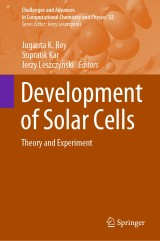Details

Development of Solar Cells
Theory and ExperimentChallenges and Advances in Computational Chemistry and Physics, Band 32
|
171,19 € |
|
| Verlag: | Springer |
| Format: | |
| Veröffentl.: | 12.05.2021 |
| ISBN/EAN: | 9783030694456 |
| Sprache: | englisch |
Dieses eBook enthält ein Wasserzeichen.
Beschreibungen
This book presents a comprehensive overview of the fundamental concept, design, working protocols, and diverse photo-chemicals aspects of different solar cell systems with promising prospects, using computational and experimental techniques. It presents and demonstrates the art of designing and developing various solar cell systems through practical examples. Compared to most existing books in the market, which usually analyze existing solar cell approaches this volume provides a more comprehensive view on the field. Thus, it offers an in-depth discussion of the basic concepts of solar cell design and their development, leading to higher power conversion efficiencies. The book will appeal to readers who are interested in both fundamental and application-oriented research while it will also be an excellent tool for graduates, researchers, and professionals working in the field of photovoltaics and solar cell systems. <br>
<p>Recent Progress in Perovskite Solar Cell: Fabrication, Efficiency, and Stability.- State-of-the-Art of Solution-Processed Crystalline Silicon/Organic Heterojunction Solar Cells: Challenges and Future.- Structure, Electronic and Charge Transfer Properties of Organic Photovoltaics from Density Functional Theory Methods.- Dye-Sensitized Solar Cells: A Brief Historical Perspective and Uses in Multijunction Devices.- Delving Charge-Transfer Excitations in Hybrid Organic-Inorganic Heterojunction of Dye-Sensitized Solar Cell: Assessment of Excitonic Optical Properties Using the GW and Bethe–Salpeter Green's Function Formalisms.- Promising DSSCs involving organic D-pi-A and similar structures for n- and p- type semiconductors - A Theoretical Approach.- Application of QSPR Modeling in Designing and Prediction of Power- Conversion Efficient Solar Cell.- Computational Screening of Organic Dye-sensitizers for Dye-sensitized Solar Cells: DFT/TDFT Approach.- Chemometric modeling of absorption maxima of carbazole dyes used in dye-sensitized solar cells.</p><p></p><p></p><p></p><p></p>
<div><b>Dr. Juganta K. Roy</b> is a Postdoctoral Research Associate at Jackson State University (JSU), Mississippi, USA. He received his Ph.D. in Chemistry from JSU, Mississippi, USA, in 2018. Dr. Roy completed his M.S. and B.Sc. studies in Applied Chemistry & Chemical Technology from the University of Dhaka, Bangladesh, in 2008 and 2006, respectively. Since 2012 he has been working as an Assistant Professor in the Department of Applied Chemistry & Chemical Engineering, Noakhali Science & Technology University, Bangladesh. His research primarily focuses on the design of optoelectronic materials with the use of different in-silico approaches like QSAR analysis, molecular dynamics simulation of polymeric materials, and electronic structure calculations. </div><div> </div><div><b>Dr. Supratik Kar</b> is a Postdoctoral Research Associate in JSU, Mississippi, USA. He completed his B.Pharm. (2008) and M.Pharm. (2010) degree in Jadavpur University (JU), India, securing the first position in both degrees. He earned his Ph.D. (2015) from JU, India. He is a former Visiting Researcher from the University of Gdańsk, Poland, under the Marie Curie research fellowship. He has over ten years’ experience in QSAR, machine learning, and chemometric modeling studies in the field of drug design, toxicity prediction, and physicochemical property modeling. To this date, he has published over 70 research and review articles, 18 book chapters, and 2 QSAR textbooks. He is acting as a Reviewer for 50 peer-reviewed journals and has performed over 230 reviews.</div><div> </div><div><b>Prof. Jerzy Leszczynski</b> is Professor of Chemistry and President’s Distinguished Fellow at JSU, Mississippi, USA. His research activities include studies of the nature of chemical bonds, theoretical predictions of molecular potential energy surfaces, structures of weakly bonded complexes, properties of DNA fragments, interactions of explosives with soil, properties, and toxicity of nanomaterials. He has published more than 1000 refereed papers in leading journals and more than 80 book chapters. He has edited and co-edited more than 50 books and has advised 31 students who already received their Ph.D. degrees. He has been cited almost 34,000 times and carries an H-index of 88 (Google Scholar). Among his international awards are: a Guest Professorship, Chinese Academy of Sciences, Shanghai, China 2002; an Honorary Doctorates, Dnipropetrovsk National University, Ukraine 2003, and Wroclaw University of Technology, Poland 2013, Award of the Academic Council of the Taras Shevchenko National University (TSNU) of Kyiv, the most distinguished TSNU recognition, Ukraine 2013, the Maria Sklodowska Curie’s Medal (Medal for prominent chemists working permanently abroad) Polish Chemical Society, Poland 2007, Honorary Doctorates, Wroclaw University of Technology, Poland 2016. He has been shortlisted for European Academy of Sciences 2002; International Academy of Engineering,2003; Ukrainian Ecological Academy of Sciences, 2003; and European Academy of Sciences, Arts and Humanities, 2004. He received White House Award in 2001 and the USA Presidential Award in 2009.</div><div><br></div>
This book presents a comprehensive overview of the fundamental concept, design, working protocols, and diverse photo-chemicals aspects of different solar cell systems with promising prospects, using computational and experimental techniques. It presents and demonstrates the art of designing and developing various solar cell systems through practical examples. Compared to most existing books in the market, which usually analyze existing solar cell approaches this volume provides a more comprehensive view on the field. Thus, it offers an in-depth discussion of the basic concepts of solar cell design and their development, leading to higher power conversion efficiencies. The book will appeal to readers who are interested in both fundamental and application-oriented research while it will also be an excellent tool for graduates, researchers, and professionals working in the field of photovoltaics and solar cell systems. <br>
Covers state-of-the-art methodologies and recent applications of solar cell design Presents computational and experimental techniques applied in solar cell development Features contributions from leaders in the field of solar cells

















